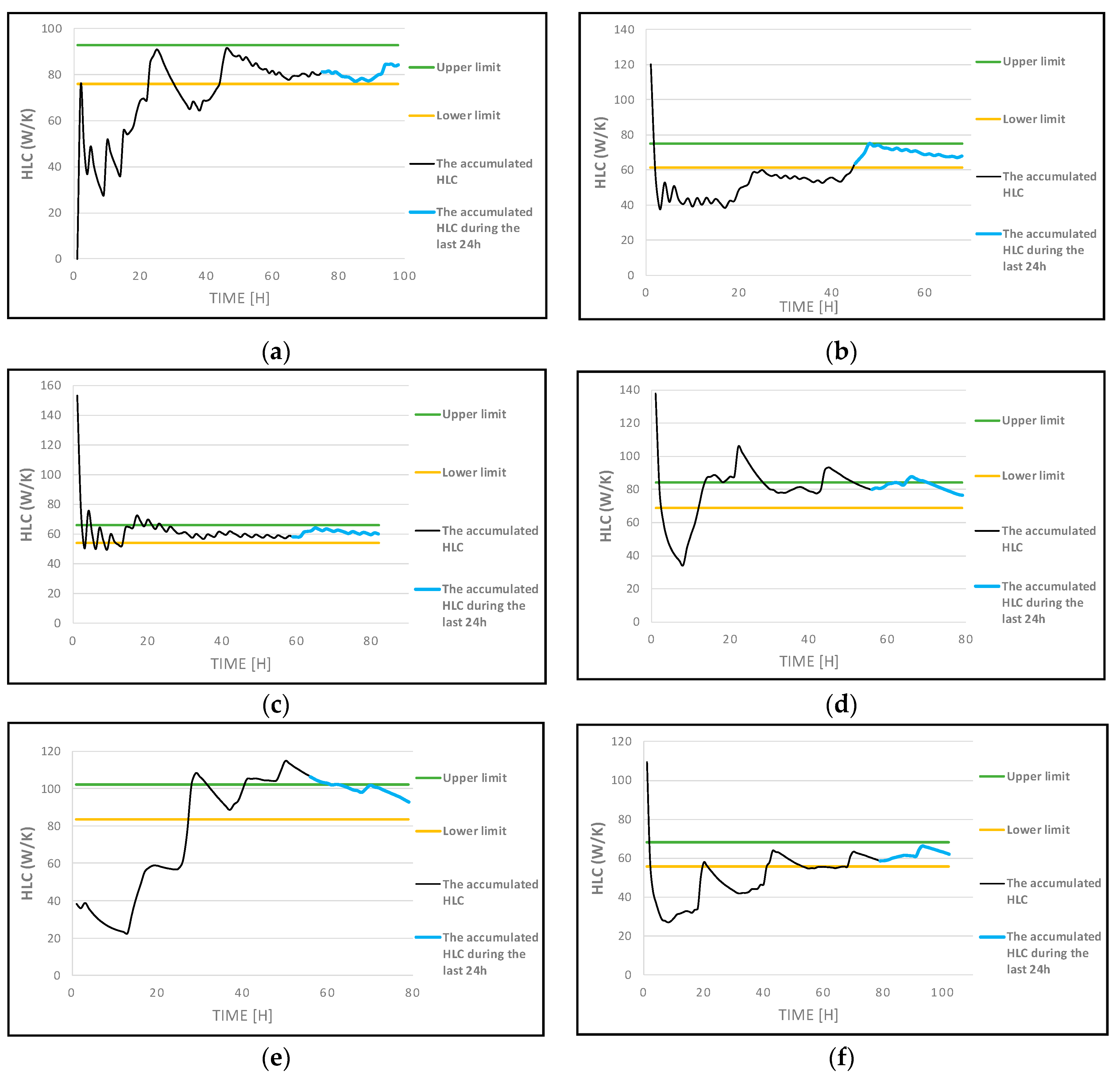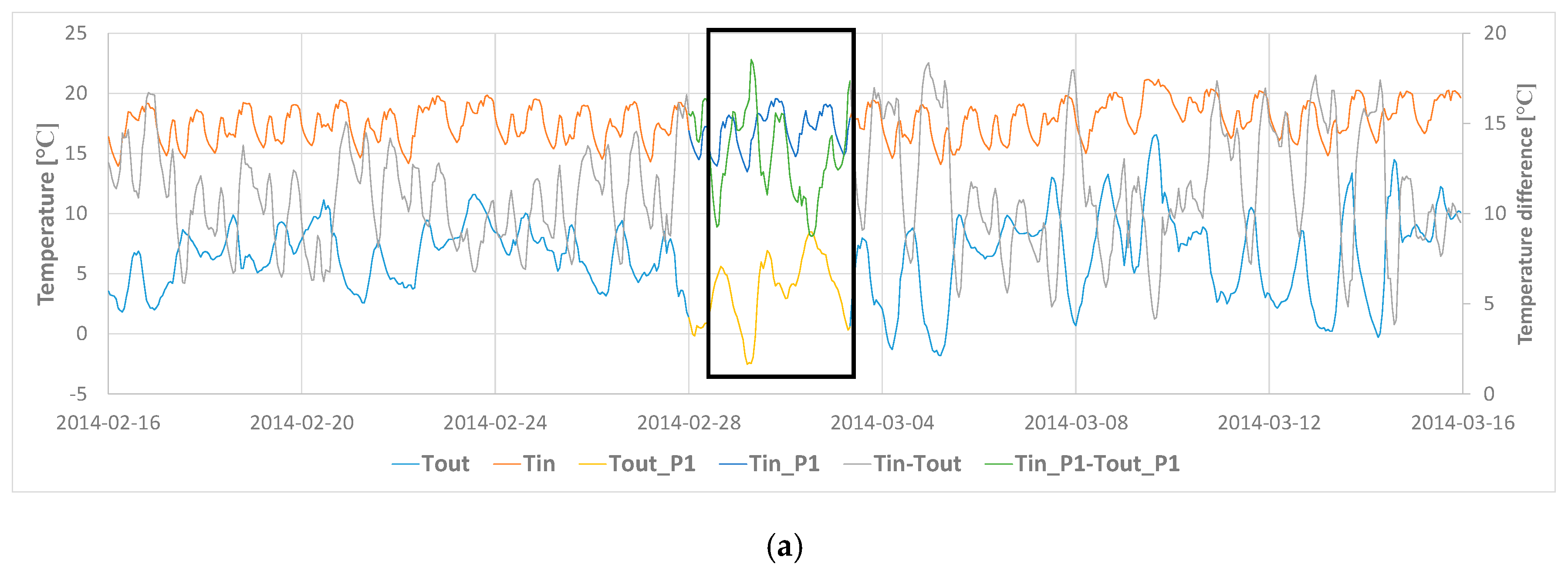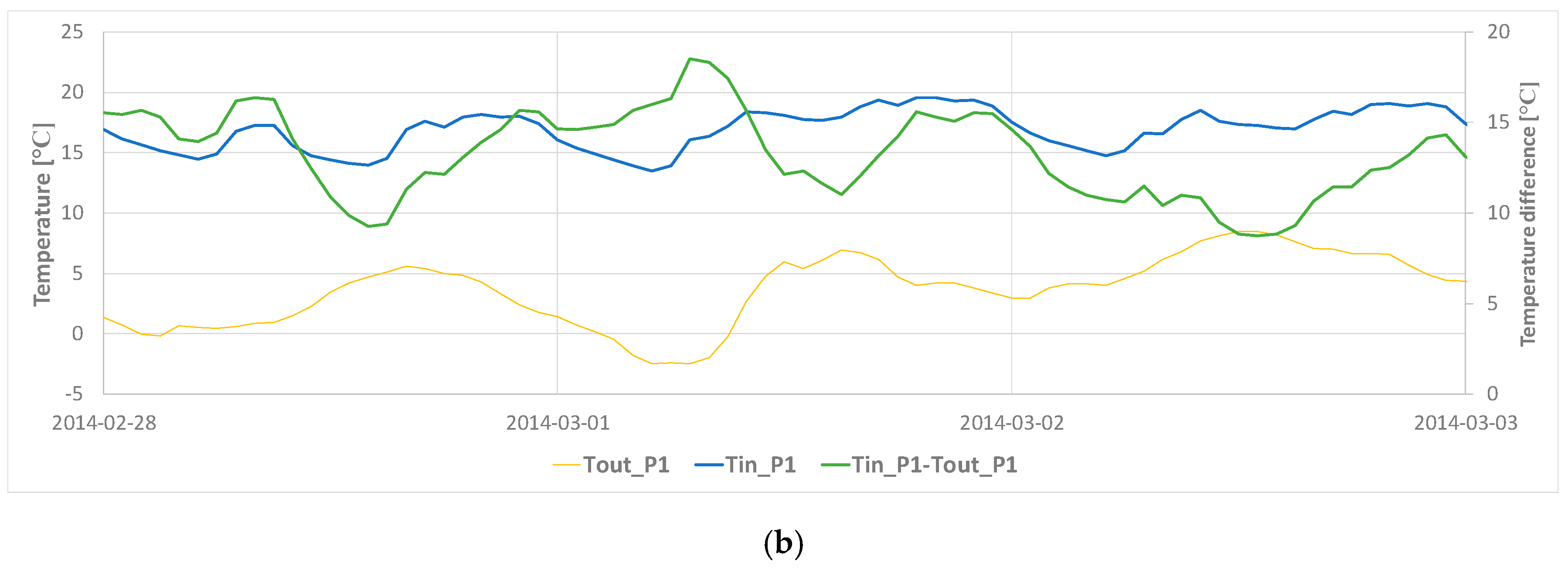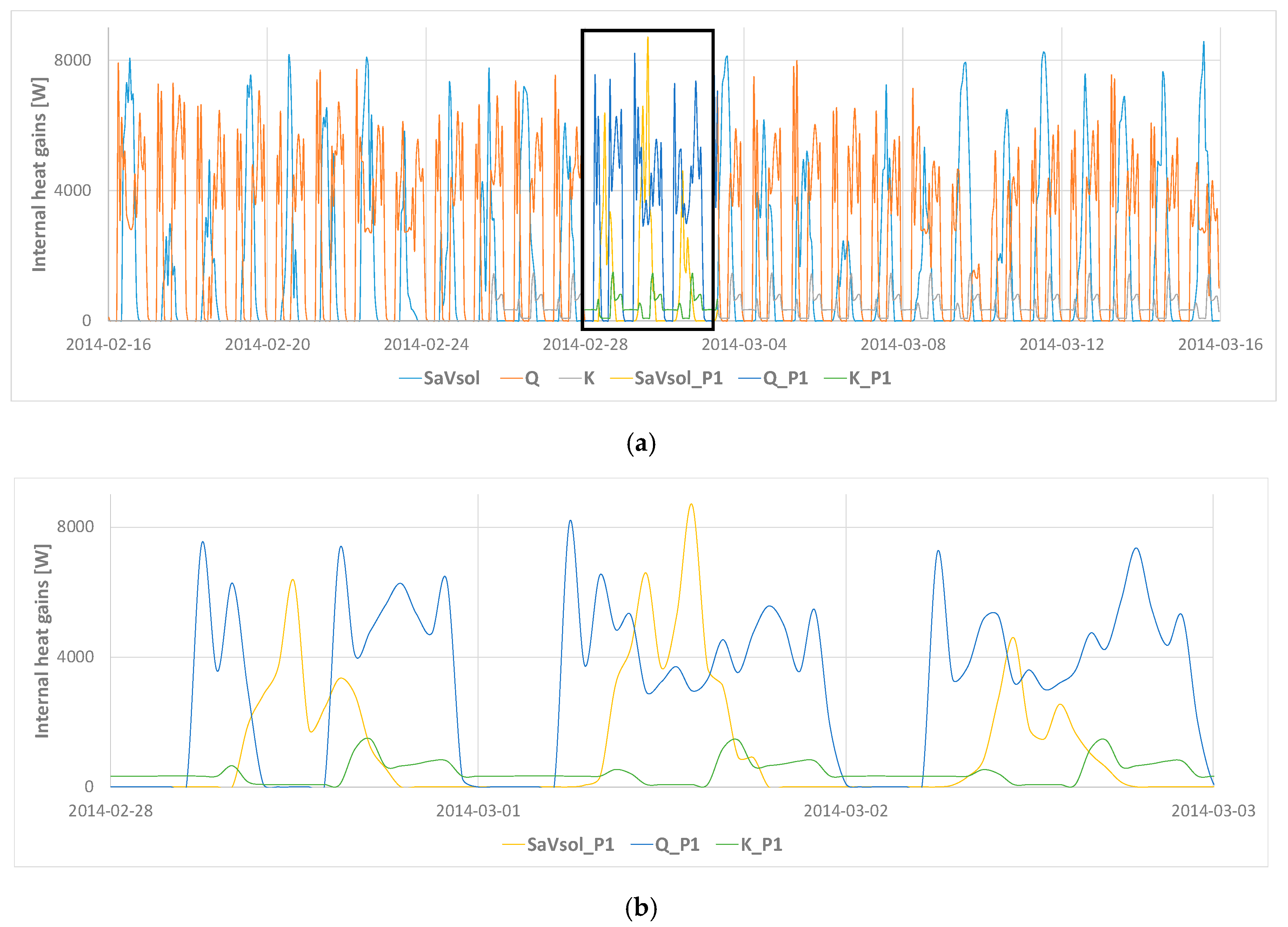Estimation of the Heat Loss Coefficient of Two Occupied Residential Buildings through an Average Method
Abstract
1. Introduction
2. Materials and Methods
2.1. Average Method
2.2. Input Data
3. Results
3.1. Gainsborough HLC Estimation
3.2. Loughborough HLC Estimation
4. Discussion
5. Conclusions
Author Contributions
Funding
Acknowledgments
Conflicts of Interest
Appendix A


References
- EU Buildings Factsheets. Available online: https://ec.europa.eu/energy/en/eu-buildings-factsheets (accessed on 31 August 2020).
- H2020 Energy Efficient Buildings (EeB). Available online: https://ec.europa.eu/commission/presscorner/detail/en/fs_19_6725 (accessed on 31 August 2020).
- Zou, P.X.W.; Wagle, D.; Alam, M. Strategies for minimizing building energy performance gaps between the design intend and the reality. Energy Build. 2019, 191, 31–41. [Google Scholar]
- Bordass, B.; Leaman, A.; Ruyssevelt, P. Assessing building performance in use 5: Conclusions and implications. Build. Res. Inf. 2001, 29, 144–157. [Google Scholar] [CrossRef]
- Menezes, A.C.; Cripps, A.; Bouchlaghem, D.; Buswell, R. Predicted vs. actual energy performance of non-domestic buildings: Using post-occupancy evaluation data to reduce the performance gap. Appl. Energy 2012, 97, 355–364. [Google Scholar] [CrossRef]
- Zou, P.X.W.; Xu, X.; Sanjayan, J.; Wang, J. Review of 10 years research on building energy performance gap: Life-cycle and stakeholder perspectives. Energy Build. 2018, 178, 165–181. [Google Scholar] [CrossRef]
- Mitterer, C.; Künzel, H.M.; Herkel, S.; Holm, A. Optimizing energy efficiency and occupant comfort with climate specific design of the building. Front. Archit. Res. 2012, 1, 229–235. [Google Scholar] [CrossRef]
- Wang, D.; Jiang, J.; Liu, Y.; Wang, Y.; Xu, Y.; Liu, J. Student responses to classroom thermal environments in rural primary and secondary schools in winter. Build. Environ. 2017, 115, 104–117. [Google Scholar] [CrossRef]
- Zhu, Y.; Fan, X.; Wang, C.; Sang, G. Analysis of heat transfer and thermal environment in a rural residential building for addressing energy poverty. Appl. Sci. 2018, 8, 2077. [Google Scholar] [CrossRef]
- Hemsath, T.L.; Bandhosseini, K.A. Sensitivity analysis evaluating basic building geometry’s effect on energy use. Renew. Energy 2015, 76, 526–538. [Google Scholar] [CrossRef]
- Montazeri, H.; Blocken, B.; Derome, D.; Carmeliet, J.; Hensen, J.L.M. CFD analysis of forced convective heat transfer coefficients at windward building facades: Influence of building geometry. J. Wind. Eng. Ind. Aerodyn. 2015, 146, 102–116. [Google Scholar] [CrossRef]
- Johnston, D.; Miles-Shenton, D.; Farmer, D. Quantifying the domestic building fabric ‘performance gap’. Build. Serv. Eng. Res. Technol. 2015, 36, 614–627. [Google Scholar] [CrossRef]
- D’Orazio, M.; Di Perna, C.; Di Giuseppe, E. Green roof yearly performance: A case study in a highly insulated building under temperate climate. Energy Build. 2012, 55, 439–451. [Google Scholar] [CrossRef]
- Martinez, R.G.; Chemisana, D.; Arrien, A.U. Dynamic performance assessment of multidimensional heat transfer in buildings. J. Build. Eng. 2019, 26. [Google Scholar] [CrossRef]
- International Energy Agency’s Energy in Buildings and Communities Programme. Available online: http://www.iea-ebc.org/projects/project?AnnexID=71 (accessed on 27 August 2020).
- DYNamic Analysis Simulation and Testing applied to the Energy and Environmental Performance of Buildings. Available online: https://dynastee.info/ (accessed on 27 August 2020).
- IEA-EBC Annex 71 “Building Energy Performance Assessment Based on In-Situ Measurements”. Available online: https://www.kuleuven.be/bwf/projects/annex71/ (accessed on 27 August 2020).
- IEA-EBC Annex. Reliable Building Energy Performance Characterisation Based on Full Scale Dynamic Measurements. In Workshop in Preparation of New IEA EBC Annex Project—Brussels April; EBC: Birmingham, UK, 2016; Volume 18, p. 19. [Google Scholar]
- Bauwens, G.; Roels, S. Co-heating test: A state-of-the-art. Energy Build. 2014, 82, 163–172. [Google Scholar] [CrossRef]
- Butler, D.; Dengel, A. Review of Co-Heating Test Methodologies: Primary Research; NHBC Foundation: Buckinghamshire, UK, 2013. [Google Scholar]
- Danov, S.; Carbonell, J.; Cipriano, J.; Martí-Herrero, J. Approaches to evaluate building energy performance from daily consumption data considering dynamic and solar gain effects. Energy Build. 2013, 57, 110–118. [Google Scholar] [CrossRef]
- Jiménez, M.J.; Heras, M.R. Application of multi-output ARX models for estimation of the U and g values of building components in outdoor testing. Sol. Energy 2005, 79, 302–310. [Google Scholar] [CrossRef]
- Bacher, P.; Madsen, H. Identifying suitable models for the heat dynamics of buildings. Energy Build. 2011, 43, 1511–1522. [Google Scholar] [CrossRef]
- Roels, S.; Bacher, P.; Bauwens, G.; Madsen, H.; Jiménez, M.J. Characterising the Actual Thermal Performance of Buildings: Current Results of Common Exercises Performed in the Framework of the IEA EBC Annex 58-Project. Energy Procedia 2015, 78, 3282–3287. [Google Scholar] [CrossRef]
- Erkoreka, A.; Garcia, E.; Martin, K.; Teres-Zubiaga, J.; Del Portillo, L. In-use office building energy characterization through basic monitoring and modelling. Energy Build. 2016, 119, 256–266. [Google Scholar] [CrossRef]
- Uriarte, I.; Erkoreka, A.; Giraldo-Soto, C.; Martin, K.; Uriarte, A.; Eguia, P. Mathematical development of an average method for estimating the reduction of the Heat Loss Coefficient of an energetically retrofitted occupied office building. Energy Build. 2019, 192, 101–122. [Google Scholar] [CrossRef]
- Sodagar, B.; Starkey, D. The monitored performance of four social houses certified to the Code for Sustainable Homes Level. Energy Build. 2016, 110, 245–256. [Google Scholar] [CrossRef]
- Beizaee, A.; Allinson, D.; Lomas, K.J.; Foda, E.; Loveday, D.L. Measuring the potential of zonal space heating controls to reduce energy use in UK homes: The case of un-furbished 1930s dwellings. Energy Build. 2015, 92, 29–44. [Google Scholar] [CrossRef]
- Building Research Establishment (BRE). SAP The Government’s Standard Assessment Procedure for Energy Rating of Dwellings; BRE: Watford, UK, 2012. [Google Scholar]
- Carmody, J.; Selkowitz, S.; Arasteh, D.; Heschong, L. Residential Windows: A Guide to New Technologies and Energy Performance; Ringgold Inc.: Portland, OR, USA, 2007. [Google Scholar]
- Duffie, J.A.; Beckman, W.A. Solar Engineering of Thermal Processes; John Wiley & Sons: New York, NY, USA, 2013. [Google Scholar]





| Sensors | Measured Parameter | Description |
|---|---|---|
| Thermocouple/Thermistors | Outdoor temperature (°C) Tout,k | On-site outdoor air temperature |
| Indoor temperature (°C) Tin,k | Measured in different rooms of the house. In order to achieve a unique temperature for the building, a non-weighted average temperature was estimated using the following formula: | |
| Energy consumption devices | Boiler heat output (kWh) Qk | When required, the gas consumption was converted by boiler efficiencies to space heating system kWh supply. Hot water energy supply is not considered in this term. |
| Total electricity consumption (kWh) Kk | Measured for the whole building or in each of the rooms of the house. | |
| Pyranometer | Solar radiation (global horizontal solar irradiance [W/m2]) Hsol | Obtained from the Waddington weather station. In order to apply the average method, it was converted into south global vertical solar radiation (Vsol) [31]. |
| Winter | Period | Input Data | |||||||||
|---|---|---|---|---|---|---|---|---|---|---|---|
[°C] | [°C] | − [°C] | [W] | [W] | [W] | [W] | |||||
| 2012–2013 | Period 1 | 2012-12-03 18:02 | → | 2012-12-07 19:02 | 2.6 | 21.2 | 18.6 | 1066.5 | 11.9 | 1078.4 | 491.7 |
| Period 2 | 2012-12-11 16:02 | → | 2012-12-14 11:02 | −0.4 | 16.9 | 17.3 | 767.9 | 22.6 | 790.5 | 380.9 | |
| Period 3 | 2012-12-18 23:02 | → | 2012-12-22 8:02 | 5.9 | 16.9 | 11.0 | 544.7 | 9.3 | 554.0 | 110.7 | |
| 2013–2014 | Period 4 | 2013-11-27 2:02 | → | 2013-11-30 8:02 | 7.0 | 21.7 | 14.7 | 326.8 | 459.2 | 786 | 336.9 |
| Period 5 | 2013-12-13 21:02 | → | 2013-12-17 3:02 | 9.5 | 21.7 | 12.2 | 393.8 | 453.7 | 847.5 | 282.0 | |
| 2014–2015 | Period 6 | 2014-11-26 3:02 | → | 2014-11-30 8:02 | 8.7 | 21.9 | 13.2 | 322.7 | 353.8 | 676.5 | 139.4 |
| Winter | Period | Output Data | |
|---|---|---|---|
[W/K] | [W/K] | ||
| 2012–2013 | Period 1 | 57.9 ± 3.5 | 84.4 ± 8.5 |
| Period 2 | 45.9 ± 2.9 | 68.0 ± 7.2 | |
| Period 3 | 50.2 ± 4.4 | 60.2 ± 6.6 | |
| 2013–2014 | Period 4 | 53.6 ± 3.8 | 76.6 ± 8.4 |
| Period 5 | 69.6 ± 5.7 | 92.7± 10.6 | |
| 2014–2015 | Period 6 | 51.4 ± 3.9 | 61.9 ± 6.1 |
| Winter | Period | Input Data | |||
|---|---|---|---|---|---|
[W] | [W] | [W] | [W] | ||
| 2012–2013 | Period 1 | 1066.5 | 406.0 | 1472.5 | 27.6 |
| Period 2 | 767.9 | 0.0 | 767.9 | 0.0 | |
| Period 3 | 544.7 | 0.0 | 544.7 | 0.0 | |
| 2013–2014 | Period 4 | 326.8 | 404.7 | 731.6 | 55.3 |
| Period 5 | 393.8 | 431.6 | 825.5 | 52.3 | |
| 2014–2015 | Period 6 | 322.7 | 46.6 | 369.2 | 12.6 |
| Winter | Period | Input Data | ||||
|---|---|---|---|---|---|---|
[°C] | [°C] | [°C] | [°C] | − [°C] | ||
| 2012–2013 | Period 1 | 2.6 | 21.2 | 21.3 | 21.2 | 18.6 |
| Period 2 | −0.4 | 18.3 | 15.4 | 16.9 | 17.3 | |
| Period 3 | 5.9 | 18.5 | 15.4 | 16.9 | 11.0 | |
| 2013–2014 | Period 4 | 7.0 | 21.3 | 22.1 | 21.7 | 14.7 |
| Period 5 | 9.5 | 21.5 | 21.9 | 21.7 | 12.2 | |
| 2014–2015 | Period 6 | 8.7 | 21.3 | 22.6 | 21.9 | 13.2 |
| Winter | Period | Input Data | |||||||||
|---|---|---|---|---|---|---|---|---|---|---|---|
[°C] | [°C] | − [°C] | [W] | [W] | [W] | [W] | |||||
| 2013–2014 | Period 1 | 2014-02-27 23:59 | → | 2014-03-03 7:59 | 3.5 | 16.8 | 13.3 | 2999.5 | 445.2 | 3444.7 | 1059.2 |
| Period 2 | 2014-03-05 22:59 | → | 2014-03-09 0:59 | 7.9 | 17.7 | 9.8 | 2410.6 | 442.3 | 2852.9 | 1032.6 | |
| Winter | Period | Output Data | |
|---|---|---|---|
[W/K] | [W/K] | ||
| 2013–2014 | Period 1 | 258.4 ± 14.4 | 337.9 ± 27.2 |
| Period 2 | 290.2 ± 21.4 | 395.2 ± 37.6 | |
| Measurement | Gainsborough Accuracy | Loughborough Accuracy |
|---|---|---|
| Indoor temperature | ±0.25 °C | ±0.2 °C |
| Gas meter | ±2% | ±2% |
| Electricity consumption | ±2% | Not provided (±2% assumed) |
| Outdoor temperature | ±0.5 °C | ±0.2 °C |
Publisher’s Note: MDPI stays neutral with regard to jurisdictional claims in published maps and institutional affiliations. |
© 2020 by the authors. Licensee MDPI, Basel, Switzerland. This article is an open access article distributed under the terms and conditions of the Creative Commons Attribution (CC BY) license (http://creativecommons.org/licenses/by/4.0/).
Share and Cite
Uriarte, I.; Erkoreka, A.; Eguia, P.; Granada, E.; Martin-Escudero, K. Estimation of the Heat Loss Coefficient of Two Occupied Residential Buildings through an Average Method. Energies 2020, 13, 5724. https://doi.org/10.3390/en13215724
Uriarte I, Erkoreka A, Eguia P, Granada E, Martin-Escudero K. Estimation of the Heat Loss Coefficient of Two Occupied Residential Buildings through an Average Method. Energies. 2020; 13(21):5724. https://doi.org/10.3390/en13215724
Chicago/Turabian StyleUriarte, Irati, Aitor Erkoreka, Pablo Eguia, Enrique Granada, and Koldo Martin-Escudero. 2020. "Estimation of the Heat Loss Coefficient of Two Occupied Residential Buildings through an Average Method" Energies 13, no. 21: 5724. https://doi.org/10.3390/en13215724
APA StyleUriarte, I., Erkoreka, A., Eguia, P., Granada, E., & Martin-Escudero, K. (2020). Estimation of the Heat Loss Coefficient of Two Occupied Residential Buildings through an Average Method. Energies, 13(21), 5724. https://doi.org/10.3390/en13215724







